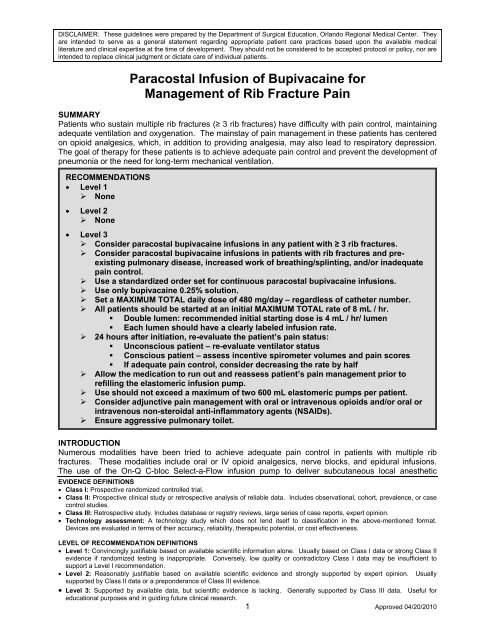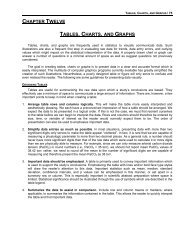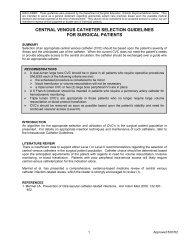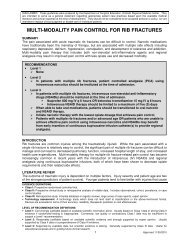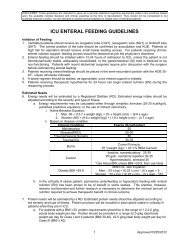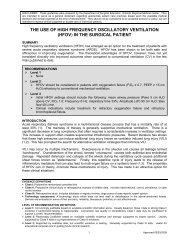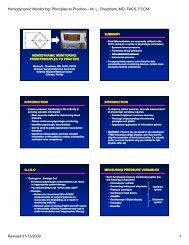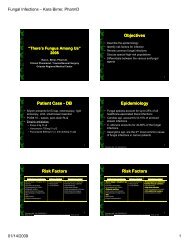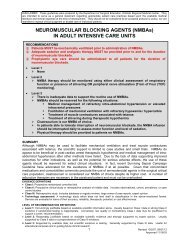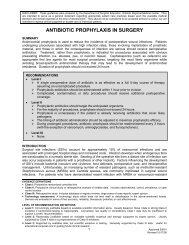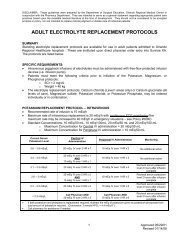Paracostal Infusion of Bupivacaine for Management of Rib Fracture ...
Paracostal Infusion of Bupivacaine for Management of Rib Fracture ...
Paracostal Infusion of Bupivacaine for Management of Rib Fracture ...
Create successful ePaper yourself
Turn your PDF publications into a flip-book with our unique Google optimized e-Paper software.
DISCLAIMER: These guidelines were prepared by the Department <strong>of</strong> Surgical Education, Orlando Regional Medical Center. Theyare intended to serve as a general statement regarding appropriate patient care practices based upon the available medicalliterature and clinical expertise at the time <strong>of</strong> development. They should not be considered to be accepted protocol or policy, nor areintended to replace clinical judgment or dictate care <strong>of</strong> individual patients.<strong>Paracostal</strong> <strong>Infusion</strong> <strong>of</strong> <strong>Bupivacaine</strong> <strong>for</strong><strong>Management</strong> <strong>of</strong> <strong>Rib</strong> <strong>Fracture</strong> PainSUMMARYPatients who sustain multiple rib fractures (≥ 3 rib fractures) have difficulty with pain control, maintainingadequate ventilation and oxygenation. The mainstay <strong>of</strong> pain management in these patients has centeredon opioid analgesics, which, in addition to providing analgesia, may also lead to respiratory depression.The goal <strong>of</strong> therapy <strong>for</strong> these patients is to achieve adequate pain control and prevent the development <strong>of</strong>pneumonia or the need <strong>for</strong> long-term mechanical ventilation.RECOMMENDATIONS• Level 1‣ None• Level 2‣ None• Level 3‣ Consider paracostal bupivacaine infusions in any patient with ≥ 3 rib fractures.‣ Consider paracostal bupivacaine infusions in patients with rib fractures and preexistingpulmonary disease, increased work <strong>of</strong> breathing/splinting, and/or inadequatepain control.‣ Use a standardized order set <strong>for</strong> continuous paracostal bupivacaine infusions.‣ Use only bupivacaine 0.25% solution.‣ Set a MAXIMUM TOTAL daily dose <strong>of</strong> 480 mg/day – regardless <strong>of</strong> catheter number.‣ All patients should be started at an initial MAXIMUM TOTAL rate <strong>of</strong> 8 mL / hr.• Double lumen: recommended initial starting dose is 4 mL / hr/ lumen• Each lumen should have a clearly labeled infusion rate.‣ 24 hours after initiation, re-evaluate the patient’s pain status:• Unconscious patient – re-evaluate ventilator status• Conscious patient – assess incentive spirometer volumes and pain scores• If adequate pain control, consider decreasing the rate by half‣ Allow the medication to run out and reassess patient’s pain management prior torefilling the elastomeric infusion pump.‣ Use should not exceed a maximum <strong>of</strong> two 600 mL elastomeric pumps per patient.‣ Consider adjunctive pain management with oral or intravenous opioids and/or oral orintravenous non-steroidal anti-inflammatory agents (NSAIDs).‣ Ensure aggressive pulmonary toilet.INTRODUCTIONNumerous modalities have been tried to achieve adequate pain control in patients with multiple ribfractures. These modalities include oral or IV opioid analgesics, nerve blocks, and epidural infusions.The use <strong>of</strong> the On-Q C-bloc Select-a-Flow infusion pump to deliver subcutaneous local anestheticEVIDENCE DEFINITIONS• Class I: Prospective randomized controlled trial.• Class II: Prospective clinical study or retrospective analysis <strong>of</strong> reliable data. Includes observational, cohort, prevalence, or casecontrol studies.• Class III: Retrospective study. Includes database or registry reviews, large series <strong>of</strong> case reports, expert opinion.• Technology assessment: A technology study which does not lend itself to classification in the above-mentioned <strong>for</strong>mat.Devices are evaluated in terms <strong>of</strong> their accuracy, reliability, therapeutic potential, or cost effectiveness.LEVEL OF RECOMMENDATION DEFINITIONS• Level 1: Convincingly justifiable based on available scientific in<strong>for</strong>mation alone. Usually based on Class I data or strong Class IIevidence if randomized testing is inappropriate. Conversely, low quality or contradictory Class I data may be insufficient tosupport a Level I recommendation.• Level 2: Reasonably justifiable based on available scientific evidence and strongly supported by expert opinion. Usuallysupported by Class II data or a preponderance <strong>of</strong> Class III evidence.• Level 3: Supported by available data, but scientific evidence is lacking. Generally supported by Class III data. Useful <strong>for</strong>educational purposes and in guiding future clinical research.1 Approved 04/20/2010
(bupivacaine or ropivacaine) in patients with rib fractures is a newer modality. The literature available tosupport this modality is limited primarily to case series and abstracts.INDICATIONS• The use <strong>of</strong> continuous paracostal infusion <strong>of</strong> bupivacaine may be considered in any patient withmultiple (≥ 3) rib fractures (3,4,6,7).• The use <strong>of</strong> continuous paracostal infusion <strong>of</strong> bupivacaine may also be considered in patients with ribfractures and additional co-morbidities including:‣ Pre-existing pulmonary disease‣ Increased work <strong>of</strong> breathing and/or splinting‣ Inadequate pain control• Elderly patients (age > 55 years), especially those with preexisting pulmonary disease, may benefitfrom the use <strong>of</strong> a continuous paracostal bupivacaine infusion even if they have < 3 rib fractures.LITERATURE REVIEW<strong>Bupivacaine</strong> Pharmacology<strong>Bupivacaine</strong> is an amide-type long-acting local anesthetic. It has an onset <strong>of</strong> action <strong>of</strong> 5-10 minutes witha duration <strong>of</strong> action <strong>of</strong> up to 7 hours (1). The plasma half-life <strong>of</strong> bupivacaine is approximately 2-2.5 hours(2). <strong>Bupivacaine</strong> causes local or regional anesthesia through stabilization <strong>of</strong> neural membranes andprevention <strong>of</strong> nerve impulse transmission (1). In additional to local anesthesia, bupivacaine also causesstimulation <strong>of</strong> the central nervous system (CNS), decreased electrical excitability in the myocardium, andmay inhibit platelet aggregation (1). These effects lead to the primary adverse events described withbupivacaine. <strong>Bupivacaine</strong> is intended to provide local or regional anesthesia via epidural,subcutaneous/intradermal (local), intrapleural, retrobulbar, or peripheral nerve blocks. It is not intended tobe administered intravenously.Adverse Events<strong>Bupivacaine</strong> is not without adverse events when given in large doses and/or administered intravenously.<strong>Bupivacaine</strong> does stimulate the CNS and at high serum concentrations (> 4 mcg/mL in adult patients)may result in restlessness, tremor, nystagmus, and clonic convulsions (1,2). <strong>Bupivacaine</strong> is also amyocardial depressant and when given in high doses or by intravenous injection may lead to bradycardia,hypotension, heart block, ventricular arrhythmias (including ventricular fibrillation) and cardiac arrest (1,2).Prolonged (2-3 weeks) epidural infusion <strong>of</strong> bupivacaine has also been associated with elevation <strong>of</strong> liverfunction tests which resolved upon discontinuation <strong>of</strong> the infusion (1). Finally, there is some in vitro datathat suggests bupivacaine may inhibit platelet aggregation (1). Intravenous lipid infusions may be usedas part <strong>of</strong> the treatment <strong>of</strong> the severe adverse events (cardiovascular & neuro) – the usual starting doseis 1.5 mL/kg bolus <strong>of</strong> 20% lipid emulsion, then 0.25 mL/kg/min <strong>for</strong> 30-60min. The bolus may be repeatedand the infusion rate increased to 0.5 mL/kg/min if there is no clinical improvement (1).Use <strong>of</strong> continuous paracostal infusion <strong>of</strong> bupivacaine via an elastomeric pump <strong>for</strong> rib fracturesEpidural anesthesia or intercostal nerve blocks have been well described <strong>for</strong> the treatment <strong>of</strong> painassociated with rib fractures. In contrast, the use <strong>of</strong> subcutaneously-placed catheters to deliverbupivacaine locally to treat pain in patients with rib fractures is a relatively new procedure. Truitt et al.described the procedure and have provided an educational video to assist with learning the technique(http://filesanywhere.com/fs/v.aspx?v=896f638e5f636faf6b6e).Truitt et al. provided the results <strong>of</strong> their clinical experience with the subcutaneously-placed catheters andinfusion <strong>of</strong> ropivacaine controlled by an elastomeric pump. They evaluated the results in ten adultpatients who had >3 unilateral rib fractures after blunt trauma. They demonstrated a decrease in painscores and an increase in lung volumes (pre-placement incentive spirometer (IS) volume = 0.5 L, postplacementIS = 1.1 L) after placement <strong>of</strong> the catheters and initiation <strong>of</strong> the infusion. None <strong>of</strong> the patientsrequired mechanical ventilation or developed pneumonia. The catheters remained in place 68-84 hours(3).2 Approved 04/20/10
Halm et al. also provided results <strong>of</strong> their clinical experience with the continuous catheter-directedintercostal nerve block (CCICNB) with ropivacaine in patients with multiple rib fractures (range 4-24).They retrospectively reviewed 124 patients treated with CCICNB. The patients received an average dose<strong>of</strong> ropivacaine <strong>of</strong> 472 ± 186 mg/day <strong>for</strong> an average <strong>of</strong> 13.6 ± 6.8 days. The authors demonstratedstatistically significant decreases in pain scores (assessed using visual-analogue scales), morphineequivalent requirements and sedation, and a significant increase in incentive spirometry volumes.Twenty-nine <strong>of</strong> the 31 patients who were intubated prior to placement <strong>of</strong> the CCICNB were extubated (4).Maximal infusion rate when administered via elastomeric pumpCurrently, no published data exists; thus, the ultimate decision lies with the surgeon who inserts thedevice. Based on the package insert and manufacturer recommendations, the intravenous maximumrecommended daily dose is 400 mg/24 hours (when administered without epinephrine as is the casewhen using elastomeric pumps) (1). The elastomeric pumps allow up to 14 mL/hr. When usingbupivacaine 0.25% (2.5mg/mL) solution, a total rate <strong>of</strong> 14 mL/hr provides 840 mg/24 hours. There is noliterature currently available to provide in<strong>for</strong>mation on the amount <strong>of</strong> systemic absorption <strong>of</strong> bupivacainewhen administered subcutaneously to patients with rib fractures. Based on safety concerns, a consensuswas reached by the Surgical Critical Care Attending Surgeons at Orlando Regional Medical Center to seta maximum total rate (the sum <strong>of</strong> all lumens) at 8 mL/hr <strong>of</strong> 0.25% bupivacaine which provides 480 mg/24hours.Adjunctive Analgesia OptionsThere is a paucity <strong>of</strong> literature directly analyzing the efficacy and safety <strong>of</strong> systemic opioids and/or nonsteroidalanti-inflammatory agents (NSAIDs) <strong>for</strong> the treatment <strong>of</strong> pain associated with rib fractures.However, it has been well described that patients with rib fractures and poor pain control have increasedrespiratory complications (5).A review <strong>of</strong> the literature conducted by Karmakar et al., discusses the various modalities availableincluding systemic opioids, intercostal nerve block, epidural analgesia, intrathecal opioids, andtranscutaneous electrical nerve stimulation. In reviewing the literature, patients who received epiduralanesthesia or regional nerve blocks appeared to achieve better pain control and improved pulmonaryfunction as compared to the opioid-only groups. All <strong>of</strong> the studies were small and <strong>of</strong> short duration (5).Mackersie et al. evaluated the use <strong>of</strong> continuous-infusion epidural or intravenous fentanyl <strong>for</strong> painmanagement in patients with rib fractures. Both groups saw improvement in pain scores (on visualanalogue scale measurements) and improvement in ventilator function following administration <strong>of</strong>fentanyl. However, there was no statistically significant difference between the two groups (6).Ingalls et al. conducted a randomized, double-blind, placebo-controlled trial using lidocaine patch 5% inpatients with traumatic rib fractures. The results demonstrated that the patch did not provideimprovement in pain control in these patients (7).There is currently no literature on the use <strong>of</strong> NSAIDs <strong>for</strong> the treatment <strong>of</strong> pain associated with ribfractures. NSAIDs do provide adequate analgesia in many other settings and their use may frequentlylower overall opioid requirements in post-operative patients. This was demonstrated by Southworth et alin a randomized, double-blind, placebo-controlled trial on the use <strong>of</strong> intravenous ibupr<strong>of</strong>en (400 mg or 800mg per dose) <strong>for</strong> post-operative pain management. They enrolled 406 patients (87 men, 319 women)who had undergone either elective abdominal (73%) or orthopedic (27%) surgery. Patients receivedibupr<strong>of</strong>en injection 400 or 800 mg or placebo administered every 6 hours in addition to intravenousmorphine. There was a significant reduction in the median total morphine dose at 24 hours in patientsreceiving ibupr<strong>of</strong>en 800 mg IV q 6hr as compared to placebo (p=0.026). There was no differencebetween the ibupr<strong>of</strong>en 400 mg group and placebo. The ibupr<strong>of</strong>en 800 mg group also had significantreductions in pain at rest and with movement as compared to placebo (p < 0.05) (8).3 Approved 04/20/10
REFERENCES1. <strong>Bupivacaine</strong>. Micromedex <strong>for</strong> Health Systems. [Accessed 09-Mar-2010].2. Mather LE, Long GJ, Thomas J, et.al. The intravenous toxicity and clearance <strong>of</strong> bupivacaine in man.Clin Pharmacol Ther 1971; 12(6):935-943.3. Truitt M, Amos D, Mangram A, et al. Out with the old in with the new: a novel approach to treatingpain associated with rib fractures. [Unpublished Abstract – provided by Dr. Truitt 05-Feb-2010].4. Halm K, Cipolle MD, Reed A, et al. Continuous catheter intercostal nerve block a safe and effectivemethod to manage multiple rib fractures. [Unpublished Abstract – provided by I-FLOW 05-Feb-2010].5. Karmakar MK, Ho AMH. Acute pain management <strong>of</strong> patients with multiple fractured ribs. J Trauma2003; 54:615-625.6. Mackersie RC, Karagianes TG, Hoyt DB, et al. Prospective evaluation <strong>of</strong> epidural and intravenousadministration <strong>of</strong> fentanyl <strong>for</strong> pain control and restoration <strong>of</strong> ventilator function following multiple ribfractures. J Trauma 1991; 31(4):443-451.7. Ingalls NK, Horton ZA, Bettendorf M, et al. Randomzied, double-blind, placebo-controlled trial usinglidocaine patch 5% in traumatic rib fractures. J Am Coll Surg 2010; 210:205-209.8. Southworth S, Peters J, Rock A, et al. A multicenter, randomized, double-blind, placebo-controlledtrial <strong>for</strong> intravenous ibupr<strong>of</strong>en 400 and 800 mg every 6 hours in the management <strong>of</strong> postoperativepain. Clin Ther 2009; 31:1922-1935.4 Approved 04/20/10


